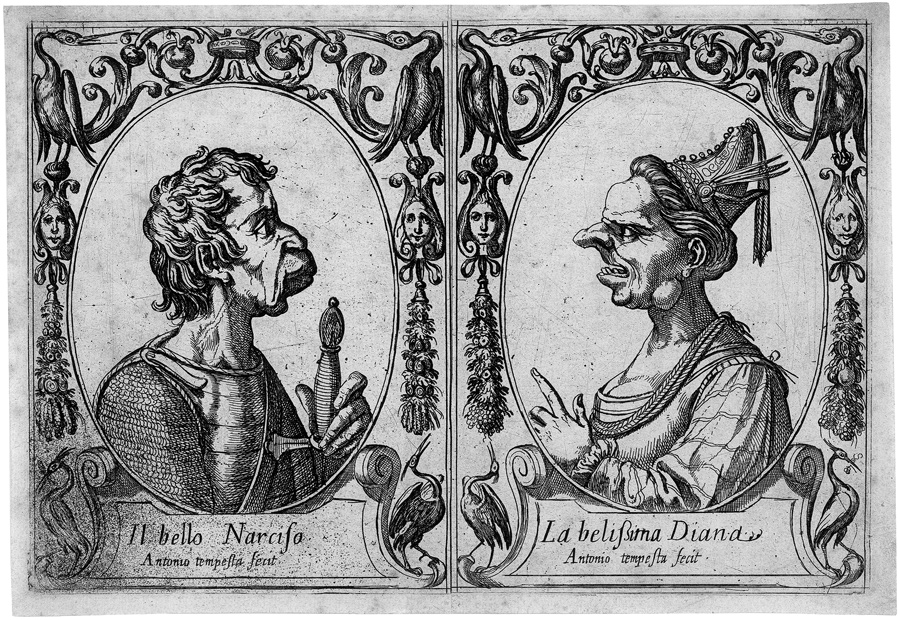Loading the page ...
Antonio Tempesta
(1555 Florence – 1630 Rome)
“Il bello Narciso; La belissima Diana”, two grotesque portraits in profile. Two etchings joined together in the middle. Each measuring approx. 14.7 x 10.8 cm. Bartsch XVII, 180, 1368 and 1369; The Illustrated Bartsch, vol. 37 (17), p. 203; S. Samek Ludovici, “Caricature inedite di Antonio Tempesta”, in Studi di biblioteconomia e storia del libro in onore di Francesco Barberi, Rome, 1976, pp. 513–517.
The Florence-born painter and engraver Antonio Tempesta began his career as a pupil of Santi di Tito and then studied under Jan van der Straet, a native of Flanders also known as Stradanus, with whom he collaborated from 1563 to 1565 under the aegis of Giorgio Vasari on the decoration of the Salone dei Cinquecento in the Palazzo Vecchio. From about 1580 Tempesta was working in Rome, where he became friends with the Flemish painter Mathijs Bril. Together with Bril he took part in a commission for Pope Gregory XIII to paint the loggias on the third floor of the Vatican Palace.
Although Tempesta had already done designs for other engravers in the 1580s, the first prints he executed by himself date from the year 1589, thus marking the beginning of an extremely productive and successful career. These two etchings belong to a group of twelve prints in all, which Bartsch mistakenly described as a set of Roman heroes and heroines, “représentés d’une manière grotesque et des plus burlesques”. There can be no doubt, however, that Tempesta’s inventions come from Ludovico Ariosto’s epic Orlando Furioso. His caricatures of Ariosto’s characters go back to a pictorial tradition which began with the grotesque portraits of Leonardo da Vinci. In this specific case Tempesta was probably inspired by the engraving Otto teste grottesche delle Divinità dell’Olimpo by Ambrogio Brambilla (Milan, active in Rome 1575–1590). The print shows eight caricatures of Greek gods and goddesses, including Narcissus and Diana. But these bizarre creatures hardly look like lofty Olympians. They are a motley collection of human monsters, whose grotesquely distorted physiognomies give the lie to the myth of divine beauty. The coarse folk humour contained in portrayals of this kind ensured them great popularity not only in Italy, but also in Flanders. Before the painter and engraver Brambilla went to Rome in or about 1575, he lived and worked in Milan, where he belonged to the Accademia della Val di Blenio, a literary society with a great predilection for parody and satire. For this reason their members were doubtless familiar with Leonardo’s teste caricate and the grotesque teste composte of Arcimboldo (see F. Paliaga, “Giovanni Ambrogio Brambilla, le teste di carattere di Leonardo e la commedia dell’arte”, in Raccolta Vinciana 26 (1995), p. 225).
In Rome, Brambilla distinguished himself as an engraver, cartographer and illustrator, working for such renowned publishers as Claude Duchet, Pietro de’Nobili and Nicolas van Aelst. In this way Brambilla may also have come into contact with Antonio Tempesta. Although Italy can boast a rich tradition of grotesque portraits during the second half of the Cinquecento, Tempesta’s caricature cycle remains an isolated case and the prints of this cycle are extremely rare.
Superb impressions with rich tone and margins. Very slightly foxed, minor creasing verso, otherwise in excellent condition.
